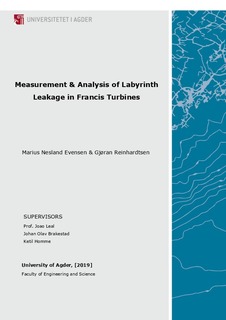| dc.description.abstract | Thismaster’sthesisis discussing the potential of measured leakage water from Francis turbines in Brokkeand Holenpower plants. There is a leakage that represent a loss, coming from the labyrinth seals in the turbines’runners (crown and band side),and this leakage will increase over time.For this report theleakage from the upper labyrinth side (crown) has been measured.The leakage is different between the four Francis turbines at Brokke and between the three Francis turbines at Holen power station.Portaflow 220Bhas been used, whichis a flow instrument using ultrasonic sound. The measuring instrument was tested and verified before doing the measurements in the power plants.The test has been done on a swimming pool purification system, that has the samesized pipeas Brokkeand Holen.This test was done in the Energy research project.The logging program, together with the Fuji Electrics Portaflow hasbeen testedin this master’s and also on the purification system at Spicheren. Comparing the measured results with the results from the purification system own measuring instrument, gives us an idea of how good the results from Portaflow220Bare. Different setups-and measuring pointshave also been tested, and the results showedthat“reflex mode” makes the most reliable results together with measuring point nr.2.After the amount of leakage water was measured, the potential of this water was investigated. This potential is bigger than the compared values from other turbines that are presented in the literature. To see the total leakage loss for the turbines (both upper and lower leakage combined), the lower band side leakage had to be analyzed. This with the help of leakage relationships found in the literature. The results ofthe measurement at Brokkeand Holenshow that turbine 4at Brokkehas the biggest amount of leakage,also whenthe results arecompared with different power.The turbines at both Brokke and Holen show a pattern that follows the active power, due to the change in production water. The leakage is linear with the power change. Turbine 4 at Brokke can be seen as the worst graded turbine. This can be explained by multiple operational hours, and the eldest revision accomplished in 1998. Turbines1 and 2 at both Brokke and Holen are stable in terms of leakage water compared with others found in the literature. Holen 3 did have a notable leakage, but in terms of the conditionsfor the high head turbine this potential is rated as a “healthier” turbine, than turbine 4.Further investigation onsolutionsthat could reduce the amount of leakage, specially from turbine 4 at Brokke would be interesting to look at in the further work on this topic. It will be a costly repairto change the turbine runner, and it is impossible tochange operational pattern to pay attention to the leakage. | nb_NO |

